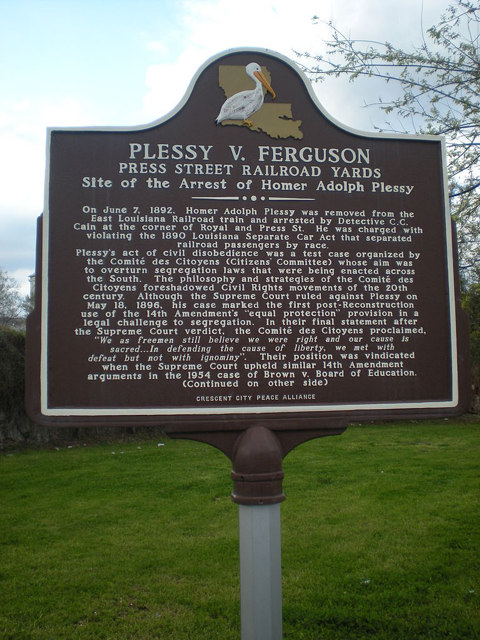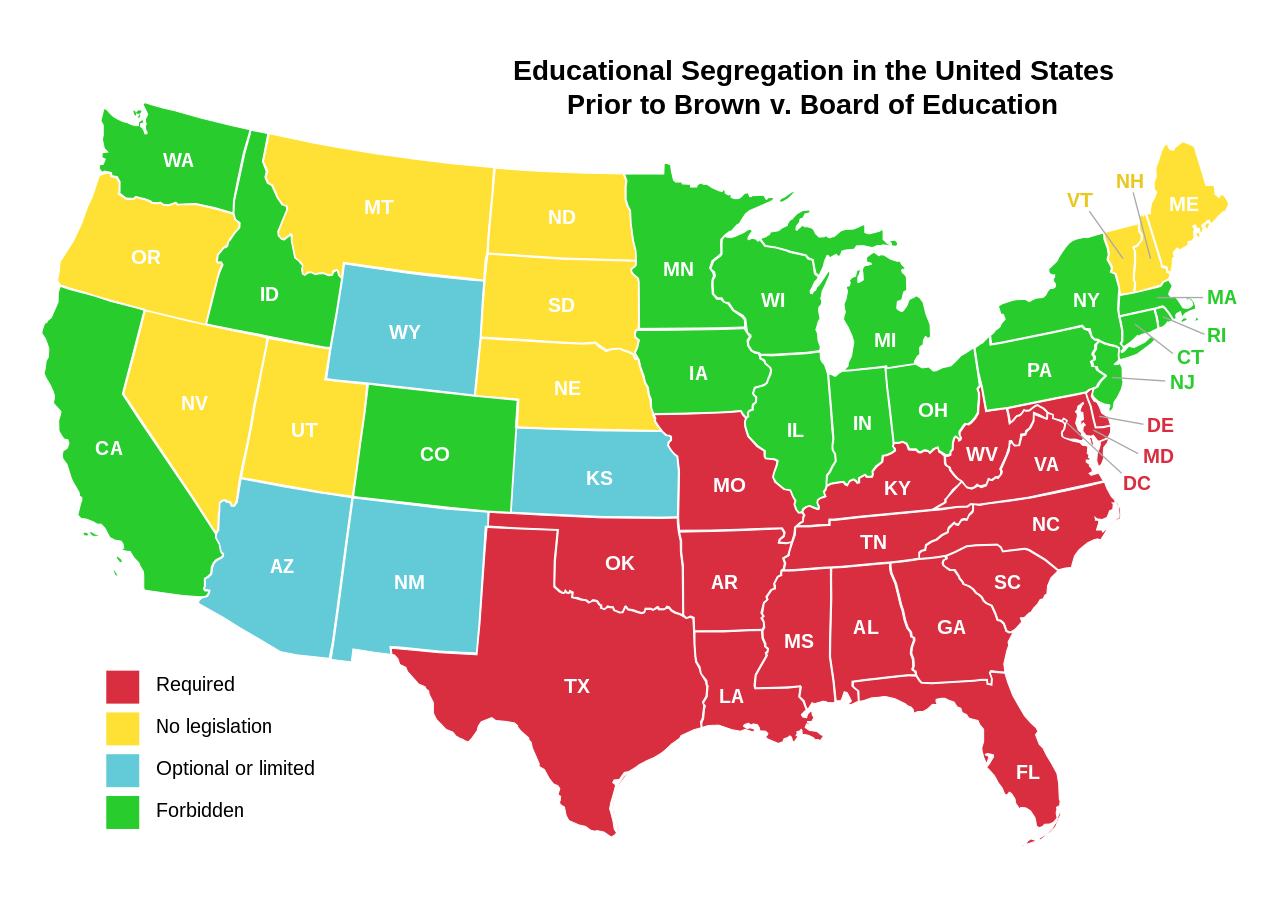“I can ride in first-class cars on the railroads and in the streets,” wrote journalist T. McCants Stewart. “I can stop in and drink a glass of soda and be more politely waited upon than in some parts of New England.” Perhaps Stewart’s comments don’t seem newsworthy. Consider that he was reporting from South Carolina in 1885 and he was black.

A marker in New Orleans stands where Homer Plessy was arrested in 1892. His case ultimately reached the U.S. Supreme Court and resulted in an infamous decision creating the legal doctrine of “separate, but equal.” (Wikimedia Commons)
Stewart had decided to tour the South because he feared for freedmen’s liberties. In 1868, with Amendment XIV, the Constitution had finally given black men full citizenship and promised them equal protection under the law. Blacks voted, won elected office, and served on juries. However, 10 years later, federal troops withdrew from the South, returning it to local white rule. And now, the Republican Party, champion of Reconstruction and freedmen’s rights, had fallen from national power. Would black people’s rights survive?
After a few weeks on the road, Stewart decided they would. True, terrorism against blacks — lynching, rape, arson — ran unchecked. True, many rural blacks lived under a sharecropping system little better than slavery. But Stewart noted many signs of change. He saw a black policeman arrest a white criminal. He saw whites casually talk with black strangers. “The morning light is breaking,” he told his readers.
Stewart was wrong. Over the next 20 years, blacks would lose almost all they had gained. Worse, denial of their rights and freedoms would be made legal by a series of racist statutes, the Jim Crow laws.
“Jim Crow” was a derisive slang term for a black man. It came to mean any state law passed in the South that established different rules for blacks and whites. Jim Crow laws were based on the theory of white supremacy and were a reaction to Reconstruction. In the depression-racked 1890s, racism appealed to whites who feared losing their jobs to blacks. Politicians abused black people to win the votes of poor whites. Newspapers fed the bias of white readers by playing up (sometimes even making up) black crimes.
In 1890, in spite of its 16 black members, the Louisiana General Assembly passed a law to prevent black and white people from riding together on railroads. Plessy v. Ferguson, a case challenging the law, reached the U.S. Supreme Court in 1896. Upholding the law, the court said that public facilities for blacks and whites could be “separate but equal.” Soon, throughout the South, they had to be separate.
Two years later, the court seemed to seal the fate of black Americans when it upheld a Mississippi law designed to deny black men the vote. Given the green light, Southern states began to limit the voting right to those who owned property or could read well, to those whose grandfathers had been able to vote, to those with “good characters,” to those who paid poll taxes. In 1896, Louisiana had 130,334 registered black voters. Eight years later, only 1,342, 1 percent, could pass the state’s new rules.
Jim Crow laws touched every part of life. In South Carolina, black and white textile workers could not work in the same room, enter through the same door, or gaze out of the same window. Many industries wouldn’t hire blacks: Many unions passed rules to exclude them.
In Richmond, one could not live on a street unless most of the residents were people one could marry. (One could not marry someone of a different race.) By 1914, Texas had six entire towns in which blacks could not live. Mobile passed a Jim Crow curfew: Blacks could not leave their homes after 10 p.m. Signs marked “Whites Only” or “Colored” hung over doors, ticket windows, and drinking fountains. Georgia had black and white parks. Oklahoma had black and white phone booths.
Prisons, hospitals, and orphanages were segregated as were schools and colleges. In North Carolina, black and white students had to use separate sets of textbooks. In Florida, the books couldn’t even be stored together. Atlanta courts kept two Bibles: one for black witnesses and one for whites. Virginia told fraternal social groups that black and white members could not address each other as “Brother.”
Though seemingly rigid and complete, Jim Crow laws did not account for all of the discrimination blacks suffered. Unwritten rules barred blacks from white jobs in New York and kept them out of white stores in Los Angeles. Humiliation was about the best treatment blacks who broke such rules could hope for. Groups like the Ku Klux Klan, which revived in 1915, used venom and violence to keep blacks “in their place.”
More than 360,000 black men served in World War I. The country welcomed them home with 25 major race riots, the most serious in Chicago. White mobs lynched veterans in uniform. Black Americans fought back. The National Association for the Advancement of Colored People, founded in 1909, and the Urban League publicized abuses and worked for redress.
 |
| (Wikimedia Commons) |
Though they drew support from both races, these groups barely stemmed the tide. The 1920s and 30s produced new Jim Crow laws. By 1944, a Swede visiting the South pronounced segregation so complete that whites did not see blacks except when being served by them.
But World War II changed America, inside and out. The link between white supremacy and Hitler’s “master race” could not be ignored. Jim Crow shocked United Nations delegates who reported home about the practice. “Racial discrimination furnishes grist for the Communist propaganda mills,” said a government spokesman. “It raises doubt even among friendly nations as to the intensity of our devotion to the democratic faith.”
In 1948, President Harry Truman took decisive action to promote racial equality. He urged Congress to abolish the poll tax, enforce fair voting and hiring practices, and end Jim Crow transportation between states. Four Southern states abandoned Truman’s Democratic Party in protest. Then, as commander in chief, Truman ordered the complete integration of the armed forces. He did not wipe out racism, but, trained to obey commands, officers complied as best they could. In Korea, during the 1950s, integrated U.S. forces fought their first war.
Back at home, when the new Eisenhower administration downplayed civil rights, federal courts took the lead. In 1950, the NAACP decided to challenge the concept of “separate but equal.” Fed up with poor, overcrowded schools, black parents in South Carolina and Virginia sued to get their children into white schools. Both times, federal courts upheld segregation. Both times, the parents appealed. Meanwhile, in a similar case, Delaware’s Supreme Court ordered a district to admit black students to white schools until adequate classrooms could be provided for blacks. This time, the district appealed.
The Supreme Court agreed to consider these three cases in combination with one other. In Topeka, Kansas, where schools for blacks and whites were equally good, Oliver Brown wanted his 8-year-old daughter, Linda, to attend a school close to home. State law, however, prevented the white school from accepting Linda because she was black.
On May 17, 1954, at the stroke of noon, the nine Supreme Court Justices announced their unanimous decision in the four cases, now grouped as Brown v. Board of Education. They held that racial segregation of children in public schools, even in schools of equal quality, hurt minority children. “Separate educational facilities are inherently unequal.” The practice violated the Constitution’s 14th amendment and must stop. To some, the judgment seemed the fruitful end of a long struggle. Actually, the struggle had just begun.
For Discussion and Writing
- Imagine that you were born black in 1860 and lived until 1920. Would you have any faith in the U.S. legal system? In the “American way of life”? Why or why not?
- How did Jim Crow laws affect the American image abroad? How did our foreign policy impact racial equality at home?
- Most laws are meant to promote the general welfare or protect society from an evil. Did Jim Crow laws serve these purposes? If so, how? If not, what was their purpose?
- Under Jim Crow, black facilities were often of far poorer quality than those reserved for whites. Separate rarely meant equal. If blacks and whites had received equal treatment, would Jim Crow laws have been fair?
- “I don’t believe you can change the hearts of men with laws or decisions,” said one person who opposed court ordered desegregation. Do you agree with the statement? Is it a valid reason to continue segregation?
- Read the 14th Amendment and explain how the Supreme Court used it to disallow segregation in the Brown decision. Why didn’t the Court use it for the same purpose in Plessy v. Ferguson?
For Further Reading
Packard, Jerrald M. American Nightmare: The History of Jim Crow. New York: St. Martin’s Press. 2002.
Chafe, William H. Remembering Jim Crow: African Americans Tell about Life in the Segregated South. New York: The New Press. 2001.